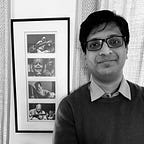TM Krishna and Vikku Vinayakaram at the Afghan Church (FEA event)
He’s back!
This past Sunday, the First Edition Arts (FEA)organised an event with TM Krishna and Vikku Vinayakaram at the beautiful Afghan Church in Colaba.
After my previous experience at a Krishna concert, which left me largely disappointed, I went in determined to be very zen — savour the atmosphere, enjoy the experience (I was there with my brother and mother, both visiting), expect little. My determination was sorely tested by the Mumbai traffic — we got there late and were split up as we could not find seats. “He’d better sing damn well” is all I could muster after being in a car for close to two hours.
The evening consisted of four parts — the first — which I largely missed — had Vikku playing a precomposed rhythmic composition on the ghatam with konnakol (voiced rhythmic syllables) accompaniment. He’s been performing this for a while now, and I remember watching him perform the same piece in New York about a decade ago.
The second was a Shyama Shastri’s Kamakshi Bangaru in Varali raga performed by TM Krishna and his accompanists. Third was Thyagaraja’s Nadopasana in Begada, with Krishna being accompanied only by Vikku. And finally was a set of three songs — largely in the “bhakti” mode — with the full contingent participating.
The FEA is quite hyperbolic in its marketing of Krishna, and had billed this evening “An Exquisite Evening”. Hoo boy!
They were right.
Vikku had a signal effect on Krishna’s music. You do not invite a senior percussionist to share centre-stage with you and then give him nothing to do by way of an accompanying role (by slowing down tempo dramatically, and by not getting through any passages of focused improvisation).
My big gripe with his previous concert was that he did not delve into any raga in a substantial way. On Sunday, his Varali and Begada alapanas — especially Begada — were substantial, committed expositions, and “full”. They were also brilliant, with unexpected phrases — it may have been at the end of a long week for Krishna, but there was nothing tired at all about his singing. The Begada alapana was followed by a tanam. Both alapana and tanam were accompanied by Vikku on the ghatam — a very successful experiment.
Both pieces also had neraval in two speeds and in the higher octaves — Krishna has in the recent past completely eschewed “2nd speed” neraval, and since his first speed is pretty slow, his neraval often devolves into a meandering swamp of syllables. Not today. All in all, there was more discipline, greater tempo, more variation, greater depth, immense succor for the listener. His strength has always been in wringing the “raga juice” out of a composition, almost better than anyone else, whatever the composition may be. He was in top form in this regard, and after listening to his Varali in that setting and then have him call out “Kamakshi” was simply elevating.
The three latter pieces were a Marathi abhang (Baare Panduranga), Purandaradasa’s Jagadodharana in Kapi and finally a song to Allah, tuned in Bihag by Krishna himself [he said that having invoked Kamakshi and Narayana he thought it fitting to end with a song on Allah, in a church, by a Hindu ensemble].
Krishna is on a mission to divorce the identity of Carnatic music from religiosity. His argument, which I fully agree with and have long held is that Carnatic music is not religious music (like say, nama sankeerthana or the bhajana sampradaya). It may have religious content, but that is not the intent of the music — the intent, like other art is to explore and express beauty in the abstract (in the case of Carnatic music, via the raga). Hence Krishna’s Poromboke Paadal and the recent collaboration with Perumal Murugan setting the poet’s works on subjects like the water and earth to Carnatic music.
If you did not know any of this though, you would have thought that he gripped by the mad faith of a dervish when singing the abhang. He is just so good at what he does. In that moment, in a church, with the name of the lord “Narayana” ringing out repeatedly, it was difficult to imagine that Tukaram himself could have added much more emotional content to a rendering of the song.
Jagadodharana had a delightful and unexpected passage of kalpanaswara improvisation at the line “Purandara Vittalana”. Arun Prakash showed his minimalist class. His mridangam was silent throughout the song, but he opened up with a brilliantly timed cascade of beats just as the last cycle of improvisation began — bringing the song to a close with a whole new sheath of majesty without for even a moment overwhelming the music.
The Bihag piece on Allah, had a pleasing lilt to it, but not a whole lot of variation. Krishna also seemed to sing all the stanzas, bringing the evening to a sedate end. Which is perhaps what the evening needed — a “cool down” period.
All in all, it was a fantastic evening. I look forward to when FEA puts up Krishna’s “regular” concert from the evening of December 9 (without Vikku), to see if the difference was in fact the indirect “Vikku” factor. If so, I hope he invites Vikku to be by his side again and again.
